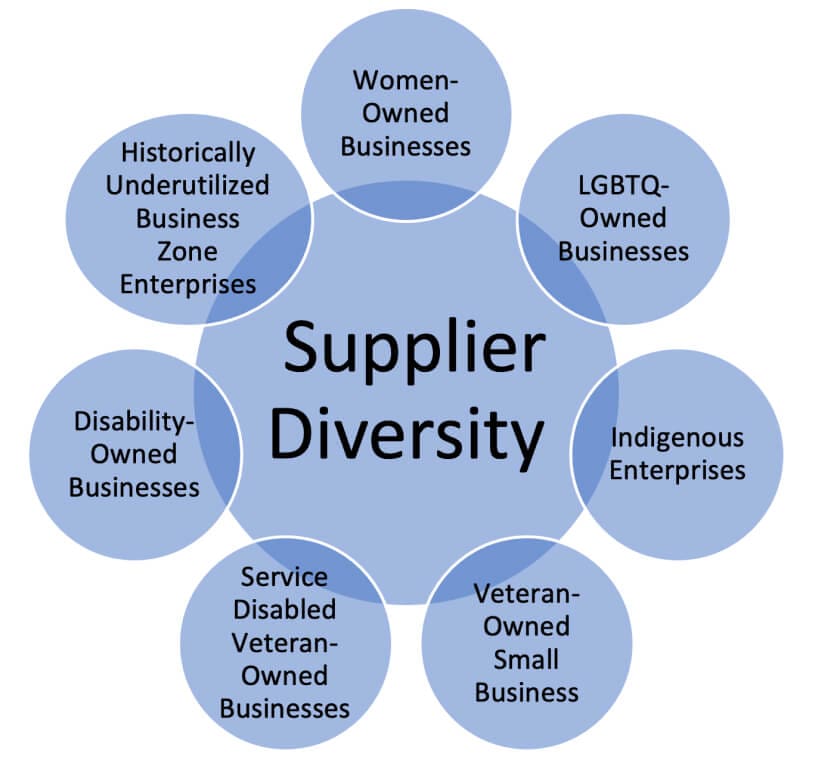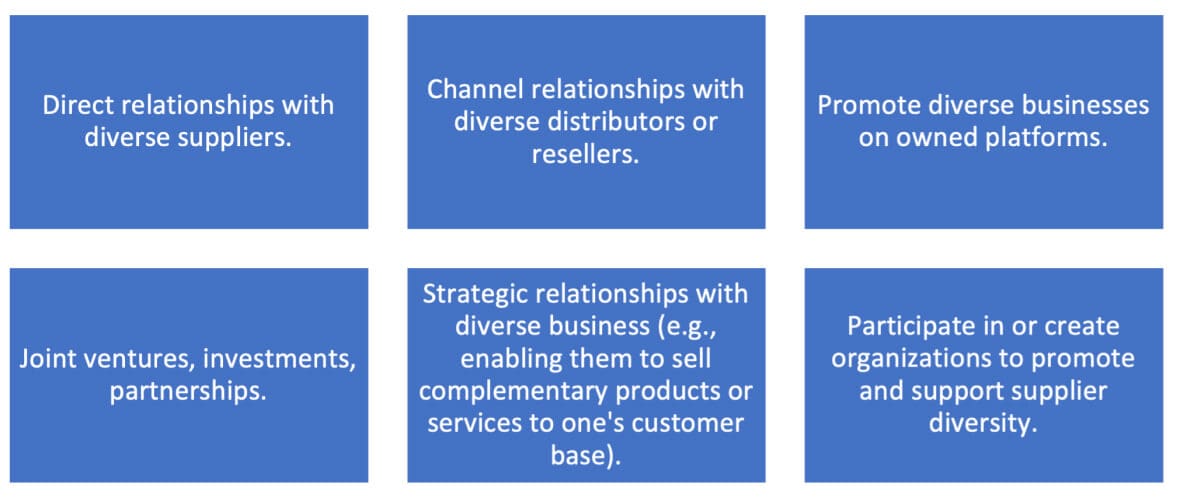Across the board, organizations are becoming more intentional about their diversity, equity and inclusion (DEI) efforts — and one of the most impactful areas to increase diversity may be within the multibillion-dollar supply chain. Initiatives to increase supplier diversity can deliver significant value, not just by countering years of discrimination and creating economic opportunity, but also by boosting the buying company's own business performance. Recognizing the impact that diverse suppliers can have, many companies have developed supplier diversity programs to make their procurement strategies more inclusive. Learn why you may want to do the same.
What Is Supplier Diversity?
Supplier diversity is a business strategy aimed at developing a more inclusive base of suppliers when procuring goods and services. Expanding business sourcing in this way offers a number of commercial and social benefits for the businesses buying from more diverse suppliers, the suppliers themselves and the broader business ecosystem and society.
The common definition of a diverse supplier is one that is majority owned (51%) and operated by an individual or group that has been historically underrepresented or underserved in the economy. The earliest supplier diversity efforts were aimed at ensuring that organizations considered small businesses, minority-owned enterprises and women-owned enterprises when making purchasing decisions. Since then, supplier diversity programs have expanded to include businesses owned by veterans, those with disabilities and members of the LGBTQ community.
Key Takeaways
- Increasing supplier diversity offers a number of commercial and social benefits.
- More inclusive business procurement can increase economic opportunities and build a more resilient business ecosystem.
- Businesses with more diverse suppliers can benefit from better-quality products and services, lower costs and increased innovation.
- Effective supplier diversity programs require dedicated investment, resources, leadership, governance and goals.
Supplier Diversity Explained
The seeds of supplier diversity in the U.S. were planted during the civil rights movement of the 1960s, when Executive Order 11246 compelled federal government entities to incorporate affirmative action into buying decisions. Responding to the social, political and economic realities of the time, General Motors, AT&T and IBM created the first supplier diversity programs.
Some progressive companies have long made it a point to take an inclusive approach to procurement. In recent years, as the commercial and social benefits of more inclusive procurement became clear, supplier diversity programs have gone mainstream. In fact, The Hackett Group's "2021 Supplier Diversity Study" of 100 large companies found that 92% allocated funds toward supplier diversity. What's more, these companies were making plans to dramatically expand their supplier diversity programs over the next few years in response to global calls for social reform and racial equality. The U.S. government is also redoubling its efforts, expanding the mandate of the Minority Business Development Agency (MBDA) to partner directly with diverse suppliers and making the federal agency permanent per the Minority Business Development Act of 2021.
Why Supplier Diversity Is Important
Companies don't have to look hard for reasons to invest in supplier diversity. There is pressure from all sides — investors, consumers and even employees — to invest in areas of environmental, social and corporate governance (ESG). Increasingly, these parties are demanding that companies consider social reform in much of what they do — so much so that it has become a "board-level issue," according to The Hackett Group report.
Experts say more inclusive sourcing can help to redress systemic racism and discrimination and generate more economic opportunities for disadvantaged communities, all of which builds a more diverse business ecosystem overall. Diverse suppliers often encounter hurdles in key areas such as access to capital and networking. Supplier diversity programs can help level the playing field. The most recent data from the U.S. Census Bureau's 2020 "Annual Business Survey" indicates there are some 1.1 million minority-owned businesses, 1.2 million women-owned businesses and 331,000 veteran-owned businesses. Creating more business opportunities for these businesses can help them grow, which can have significant network effects. For example, in 2021 certified minority-owned businesses created 1.75 million jobs, according to the National Minority Supplier Diversity Council. If companies doubled their spending with certified diverse suppliers (from $1 trillion to $2 trillion), that could generate 4 million jobs and $280 billion in additional income for minority populations and women, according to McKinsey.
Many companies measure this kind of economic impact to demonstrate the success of their supplier diversity programs. But increasing supplier diversity is about more than doing good for the communities in which a company operates. Companies with diverse suppliers do better themselves when they expand their supplier networks.
Minority- and Women-Owned Businesses (MWBEs)
At the most basic level, a diverse supplier is any business that is owned and operated by an individual or group that is part of a traditionally underrepresented or underserved population. These businesses are often collectively referred to as minority- and women-owned business enterprises (MWBEs).
Certification processes overseen by third-party agencies make it easier for companies to identify and work with the broad array of diverse suppliers in the marketplace. In the U.S., certifications are available for woman-owned business enterprises, minority-owned business enterprises, veteran-owned small businesses, service-disabled veteran-owned small businesses, veteran disability-owned business enterprises, disability-owned business enterprises, LGBTQ-owned business enterprises, historically underutilized business-zone enterprises (HUBZones) and indigenous enterprises — to name a few. Just over 20% of businesses in the U.S. were women-owned, 18.7% were minority-owned and 5.7% were veteran-owned, according to the U.S. Census Bureau's 2020 survey.
Types of Diverse Suppliers

Benefits of Supplier Diversity
Companies surveyed by The Hackett Group said they expected to double their supplier diversity spend by 2025 — and for good reason. Well-executed supplier diversity programs not only contribute to the development of a more equitable and inclusive world, but they also deliver value to the bottom line. Some common benefits of supplier diversity include:
A more competitive supply base.
Broadening the base of supply can increase competition among existing and potential suppliers, which, in turn, can increase the quality of their offerings and decrease costs.
Greater agility and resiliency.
Similarly, a more expansive supply base gives companies more options when faced with supply chain disruptions. In many cases, diverse suppliers are more flexible and quicker to adapt.
Brand value boost.
A supplier diversity program can foster goodwill and burnish a brand to its buyers, whether individual consumers or other businesses. It's also a boon for employees who take pride in working for a company that offers such a program.
Increased market share.
Companies that allocate 20% or more of their spend to diverse suppliers attribute 10% to 15% of their annual sales to their supplier diversity programs, according to The Hackett Group study. In addition, the federal government and some large companies encourage or require their suppliers to create their own diversity initiatives if they want to take advantage of new business opportunities.
Fulfillment of ESG or DEI goals.
Working with MWBEs underscores a company's commitment to diversity, equity and inclusion (DEI). A supplier diversity program can also be a critical element for companies that have a corporate mandate or goals around environmental, social and corporate governance (ESG).
Increased innovation.
Partnering with suppliers with varied experiences and backgrounds can prove beneficial in developing novel solutions and introducing new products and services.
Greater customer connection.
Increased supplier diversity can bolster a company's presence, image and impact within diverse communities. It can also empower companies to take advantage of market expansion opportunities within these communities.
What Is a Supplier Diversity Program?
Companies that are serious about expanding their partnerships with diverse suppliers can create a supplier diversity program to institutionalize their intent and create the right processes and metrics to sustain the effort over time. Supplier diversity programs and initiatives incorporate best practices — such as reviewing procurement practices and identifying diverse options for each category of spending — to ensure that qualified diverse suppliers are considered for business opportunities as they arise. These programs create clarity around the goals for supplier diversity, particular classifications or categories of focus and guidelines for procurement.
However, effective supplier diversity programs go beyond internal processes and practices to offer support to their base of diverse suppliers. Some common practices include providing certification assistance, advocacy efforts, education and training opportunities, supplier mentorship, outreach, inclusive RFP processes and requiring increased supplier diversity from other suppliers.
Perhaps most important, effective supplier diversity programs set goals for more inclusive procurement programs. Companies will set goals — usually stated as a percentage of overall procurement spending allocated to diverse suppliers — to track their progress and expand their impact over time.
Additional Avenues to Improve Supplier Diversity
Buying goods and services from diverse suppliers is not the only avenue for increasing opportunities among diverse suppliers. In some cases, it can be tricky to find MWBEs that comply with a particular company's procurement requirements, so it is important to invest in other ways. Some other avenues to improve supplier diversity include:
Channel partners.
Companies seek out diverse distributors or value-added resellers that purchase goods or services directly from suppliers and then sell them to consumers.
Platform partners.
Companies can choose to promote their MWBE business partners on their own platforms. Online retailers might highlight products from minority-owned brands, for example, boosting their profiles to a larger audience.
Strategic relationships.
Rather than buying directly from MWBEs, companies can help diverse-owned suppliers provide ancillary or complementary products to their existing customer base.
Industry groups.
Similar to sustainable supply chain initiatives, companies can form or join industry organizations designed to support, nurture and promote the growth of diverse businesses. Often these organizations will provide services, such as certification guidance, mentorship and training and matchmaking services, that enable MWBEs to take better advantage of supplier diversity program opportunities.
Joint ventures and investments.
In some cases, companies may decide to invest in MWBEs or go into business with them in the form of a joint venture or another type of formal partnership.
6 Ways to Improve Supplier Diversity

How to Create a Diverse Supplier Ecosystem
Whether in the form of direct diverse supplier relationships or other investments intended to benefit MWBEs, the ultimate goal is to create a more diverse supplier ecosystem. Doing so benefits individual businesses and also delivers social value.
Developing a supplier diversity program as an element of supply chain management is a start, but such initiatives require investment, attention and an ongoing commitment to produce results. They must also evolve along with what has become a dynamic business environment. Companies can take a number of actions to build a more diverse supplier ecosystem over time:
-
Ensure strategic alignment.
Aligning supplier diversity projects or programs with the company's strategic goals helps to ensure that more inclusive procurement processes are additive to overall performance and adhered to throughout the company. Integrating supplier diversity with other ESG initiatives is also important.
-
Fully fund the effort.
Investing in supplier diversity — with budget, human resources and attention — is essential to success.
-
Include more stakeholders.
Procurement and DEI or ESG leaders are necessarily the leads on supplier diversity, but the program will be more powerful if other key stakeholders are actively engaged. Inviting other functional or business unit leaders to participate, both within the program and in more public forums, can bolster the effort.
-
Participate in the supplier diversity community.
Many supplier diversity organizations are dedicated to advancing MWBEs. Active membership and participation not only help communities of diverse suppliers, but they also give companies greater access to and insight into their products and services. Many certification agencies and nonprofits offer best practices and playbooks to help companies elevate the performance of their supplier diversity programs.
-
Invest in diverse supplier development.
Companies don't have to invest directly in MWBEs to help them succeed. They can offer a range of services and support that help MWBEs become better suppliers. Indeed, 44% of companies surveyed by The Hackett Group said they allocated funds specifically for supplier development activities, and another 39% of companies said they planned to do so.
-
Identify internal MWBE barriers.
Helping would-be diverse suppliers overcome their own hurdles is half the battle. Impediments in the buying organization often make it difficult for MWBEs to participate and compete for your business. Take a close look at any requirements that may unintentionally be keeping more diverse suppliers out, and consider how they might be reworked to lower the barrier to entry. MWBEs may need additional help meeting cybersecurity requirements, for example.
-
Publicize broader business ecosystem diversity efforts.
Companies can highlight how they are working with MWBEs directly and indirectly outside of direct supplier relationships across the entire value chain.
-
Measure your total return on supplier diversity.
Most supplier diversity programs will measure their spending on diverse suppliers, often as a percentage of total procurement spend. But supplier diversity can have a much bigger impact than that. Calculating the greater economic impact of the program, such as the number of new jobs created or revenue generated for diverse suppliers as a result of the program, can increase buy-in and excitement around the effort.
-
Make it easy.
Go beyond increasing supply chain visibility to create clear policies and processes for identifying and onboarding diverse suppliers. The more integrated the supplier diversity processes are into everyday procurement tasks, the better.
-
Revisit sourcing choices regularly.
A particular spending category that wasn't possible or important to include in the supplier diversity program last year may make sense tomorrow. For example, new opportunities to increase diversity among Tier-2 suppliers may arise. It's important that companies continue to examine their suppliers and other partnerships with an eye toward expanding the program. As business needs shift or new opportunities emerge, companies can look for opportunities to partner with MWBEs in emerging areas of growth.
Going Beyond Tokenism
Supplier diversity is more important than ever. But companies must take care to ensure that they are not just creating a supplier diversity program reactively as a token gesture. True supplier diversity and the associated benefits require companies to do more than just check off a box that they're considering a diverse supplier for a specific type of procurement decision.
To have real impact, supplier diversity must be an integral part of both the procurement process and ultimately the larger culture of the organization. Programs that go beyond tokenism:
- Are organized to include essential elements of the procurement process rather than add-ons.
- Create clear goals and measure progress against them, ensuring their investments are making a difference.
- Commit to building long-term partnerships with MWBEs rather than looking for quick, one-off wins.
- Invest in the diverse supplier ecosystem.
- Establish oversight mechanisms to assess and audit their efforts.
Track and Improve Your Supplier Diversity Program With NetSuite
Increasing supplier diversity isn't easy — and it doesn't happen overnight. But the right technology foundation can help launch and keep these programs on track for the long haul. With NetSuite Procurement and sourcing management capabilities, companies can more easily onboard new diverse suppliers, explore opportunities for expansion with existing suppliers, track spending with individual suppliers, monitor supplier performance, calculate supplier diversity growth as a percentage of overall procurement spend and more. The right tools can increase supply chain visibility and provide easy access to relevant data for those managing supplier diversity programs.
Increasing supplier diversity is a challenge, but one with an exponential upside for individual businesses and broader ecosystems. Establishing a supplier diversity program offers companies an opportunity to address long-term discrimination, inequality and inequities in their business spending and expand economic opportunities. But it's not just a one-way street. Diverse suppliers offer businesses access to new products and services, better response in a dynamic business environment and access to new geographies, markets and demographics. And when more businesses work with more diverse suppliers, the positive impact radiates outward, increasing competition, innovation and resilience throughout the value chain.
#1 Cloud ERP
Software
Supplier Diversity FAQs
What is meant by supplier diversity?
Supplier diversity is a business strategy aimed at developing a more inclusive base of suppliers when procuring goods and services. It means specifically increasing buying from businesses that are majority owned by individuals or groups from previously underrepresented or underserved populations, such as LGBTQ-owned or Black-owned businesses.
Why is supplier diversity important?
Supplier diversity means working with a more inclusive base of suppliers when procuring goods and services. Expanding business sourcing in this way offers a number of commercial and social benefits for the businesses buying from more diverse suppliers, the suppliers themselves and the broader business ecosystem and society.
What are the diverse supplier categories?
A diverse supplier is commonly defined as at least 51% owned and operated by an individual or group that is part of a traditionally underrepresented or underserved population. Some common classifications include minority-owned enterprises (MBEs) and woman-owned enterprises (WBEs), as well as many more specific categories covering businesses owned and operated by LGBTQ individuals, veterans and those with disabilities.
How is supplier diversity measured?
Supplier diversity is most commonly measured as a percentage of overall procurement spend. However, the most advanced supplier diversity programs will also measure the broader economic impact of their initiatives, including the number of new jobs created or revenue generated for diverse suppliers as a result of the program.
How do you achieve supplier diversity?
Increasing supplier diversity takes time and dedicated resources. Organizations that are serious about improving supplier diversity make investments on a number of fronts — for example, integrating supplier diversity practices into procurement processes, supporting the diverse supplier community, participating in supplier diversity organizations and making it easier for more suppliers to do business with them.
How do you source a diverse supplier?
In some cases, finding a diverse supplier can take more effort than traditional sourcing. However, a number of diverse supplier certification agencies and nonprofits offer best practices and playbooks to help companies learn where to start. They also offer matchmaking and networking opportunities to connect them to a broader community of potential partners.
Why should you diversify your supply chain?
For one thing, key business stakeholders, including investors, customers and employees, expect companies to do so. In addition, companies that diversify their supply chain see a number of benefits, including greater competition in their supply chain (leading to increased quality and/or lower prices), improved agility and resiliency, increased brand value among current and potential customers and employees, opportunities to increase market share and expand to new markets, progress on overall ESG and DEI goals and increased innovation.









